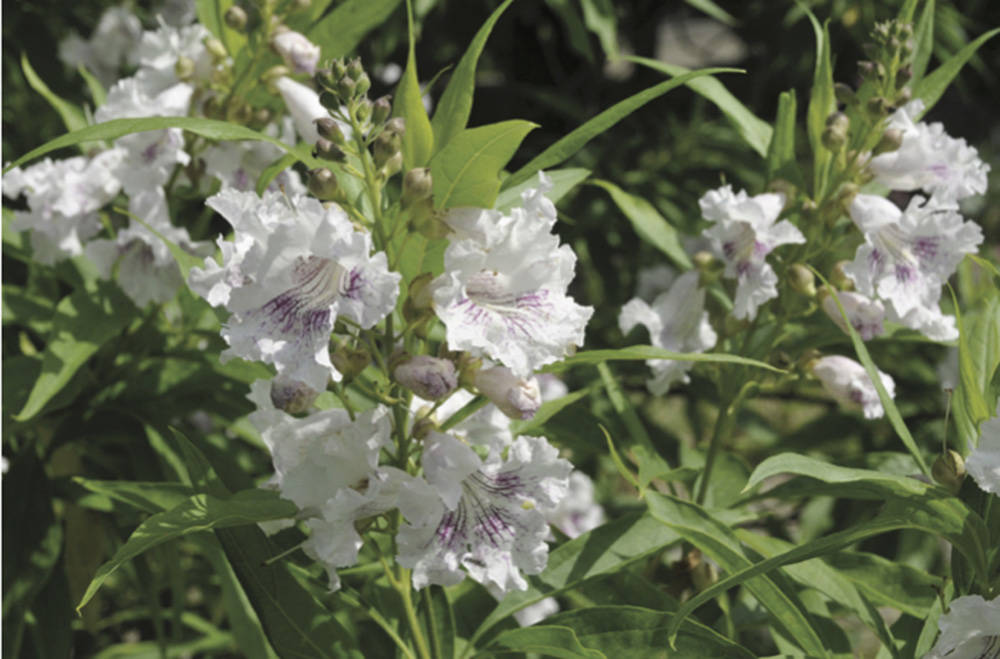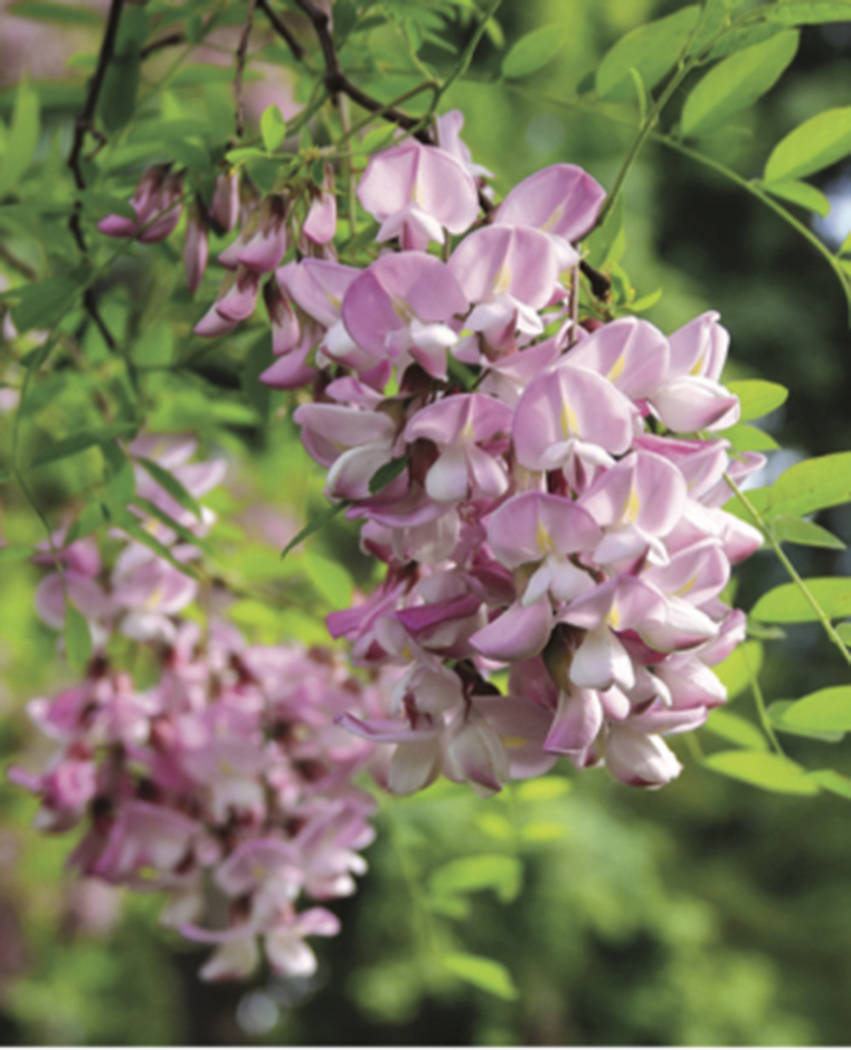Create a beautiful dry garden
Maureen Gilmer wants drought-tolerant gardens to be beautiful.
Over the past decade, “everything has become so masculinized in the landscape of America, and the emphasis now is on hardscape instead of plants as a more suitable environment for human beings to live within,” said Southern California-based Gilmer, who authors a nationally syndicated newspaper column called “Yardsmart” and has penned 20 gardening books.
Home gardeners have been sidetracked by environmental issues, terminology and trends, she said.
“I’m a total environmentalist, but I think we’ve gone off the deep end when it comes to residential landscaping. It’s gone so far (that) the general public is confused. … You can’t help the environment unless you know what you’re doing.”
Gilmer’s latest tome, “The Colorful Dry Garden: Over 100 Flowers and Vibrant Plants for Drought, Desert &Dry Times” (Sasquatch Books), was published in January. It includes guidelines for transitioning yards to an “arid palette,” as well as hundreds of photos and detailed descriptions of flowering plants and trees that provide the punches of color she and other floral fans crave.
“We’ve got drought, but that doesn’t mean that we can’t have riotous color, huge flowers (and) all the wildlife they bring,” said Gilmer, whose career in horticulture and landscape architecture spans more than three decades.
While she agrees that planting in support of pollinators and conserving water — especially in the chronically parched Southwest — is important, Gilmer said both can pose challenges for home gardeners who prefer colorful plants in their yards.
“I want them to start gardening the way they want to, not the way other people tell them to. I want your garden to be an expression of you, not some kind of global consciousness.”
Many of the trees and plants highlighted in “The Colorful Dry Garden” are likely already familiar to residents of Southern Nevada, where drought-tolerant landscaping is the norm.
Chitalpa trees are a staple in the Las Vegas Valley. A hybrid of the American desert willow and the southern catalpa, they can withstand both cold and hot temperatures while producing pretty purple-striped, curly white blossoms.
Gilmer, who also writes a weekly self-titled gardening column for the Desert Sun newspaper in Palm Springs, California, is a big fan of hybrid desert willows.
“They’ve got these huge flowers that look like orchids. Some of them are the most incredible shades of magenta red ever, and they bloom all season” before dropping their leaves in late fall, she said. In the spring, “when everything else is slowing down … these little guys kick in with the heat and go, go, go all summer long.”
Brandi Eide, a botanical gardens supervisor at the Springs Preserve, also favors desert willows.
Although the tree’s persistent seed pods can leave them looking “a little scrappy” at times, for the most part, “they’re incredibly stunning,” she said.
“There are things that you can plant year-round that will give you color, whether through flowering or foliage,” Eide said. “You can get a lot of bang for your buck with many plants that are drought tolerant. It might not be something that people think about unless they’re immersed in the plant world, but there are a ton of options.”
Fairy dusters (also known as Calliandra eriophylla) are a prime example. The perennial shrub blooms “with these puffy pink or red flowers throughout the warm months, sometimes several times a year. Those are really nice,” she said. The blooms also serve as a food source for hummingbirds and butterflies.
Better known as yellow bells, Tecoma stans are native to sandy, dry washes and rocky slopes. They can grow up to 25 feet tall, while hybrid versions range from 3 to 12 feet, and they bloom in a variety of colors, including reds and oranges. Their trumpet-shaped, clustered flowers, which burst forth in late spring and bloom through the winter-holiday season, are a favorite of hummingbirds and mason bees.
“They’re going to give you consistent color through the warm months,” said Eide, who also enjoys viewing the yellow-chartreuse flowers produced during winter by gopher plants (Euphorbia rigida), a type of sun-loving, evergreen perennial with low watering requirements.
The Idahoensis tree (also known as the Idaho locust), which can reach a height of up to 50 feet, is a hybrid that holds a special place in Gilmer’s heart. Its wisteria-like, rosy-pink blossoms make it “very traditional looking. It’s not Southwestern looking,” despite the fact that it thrives in the heat. “This Robinia (species) can do 100 (degrees) standing on its head. I’ve seen it in really hot climates.”
When it comes to plants and shrubs, desert marigolds “look really great” planted among rocks, Gilmer said. She also likes pink muhly grass, which adapts well to sandy, gravely soil; as well as gaura, a perennial that boasts quarter-sized blooms.
“That’s one of my new super favorite plants,” she said of the latter. “They’re so animated and light and transparent. That’s what I really love about them.”
Gilmer wishes more home gardeners would give the western redbud a try. The tall-growing shrub works well as an accent plant. “It gets a smoky color in the fall, and it’s got these heart-shaped leaves that are so delicate.”
The same goes for firecracker plants. The Mexico native’s tube-shaped blooms also attract hummingbirds. “These are fabulous (when grown) in pots because they dip and sag off the edges with these bright coral-colored flowers,” she said.
A wide assortment of drought-tolerant plants is available for purchase at the Springs Preserve’s annual spring plant sale, scheduled from 8 a.m.-1 p.m. Saturday and Sunday.
Ironically, Gilmer said, the most important feature of a so-called dry garden is proper irrigation.
“A lot of people do their own irrigation, and it results in problems with plants not getting enough (water),” she explained, especially in areas such as Southern Nevada, where caliche-laden soil has an extremely low absorption rate. “If there is drainage, slow-drip (irrigation) is the way to go.”
Eide said people often mistakenly believe plants need extra water to compensate for the dry, desert climate.
“The goal really is to water deeply and infrequently, so you can encourage those roots to grow down below the hot layers of soil,” where the moisture persists and temperatures aren’t as extreme. “So when we do have those hot, dry summers, (plants) actually can thrive a little bit more easily without the constant application of water.”
When transitioning from a traditional garden to a dry one, Gilmer advises taking things slowly. “Do it one plant at a time. … This is an act of love,” she said, and plant choices should come “from the heart. They should be intuitive, be it the flower shape, color, form, season. Once they’re in, you almost hardly have to do anything to them.”
Besides enjoy them, that is.
“I just want people to walk into their yard and just be blown away at the color and the beauty,” Gilmer said. “If we can get people in love with flowers again, we can really improve the state of gardening in America.”


















